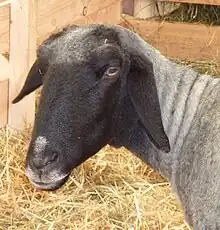 | |
| Country of origin | |
|---|---|
| Traits | |
| Weight | |
| |
The Alpines Steinschaf is a breed of domestic sheep indigenous to the Eastern Alps of Austria and southern Germany. It is used for wool, meat and vegetation management.
Etymology
The origin and meaning of the word steinschaf is unknown, though various theories have been advanced.[4]
History
The Alpines Steinschaf is one of four breeds in the Steinschaf group, the others being the Krainer Steinschaf, the Montafoner Steinschaf and the Tiroler Steinschaf.[5] They are variously thought to have derived from the mediaeval Zaupelschaf type, or from the older Torfschaf, and are believed to be the oldest sheep breeds of the eastern Alps.[3]
At the start of the twentieth century the Alpines Steinschaf was widely distributed in the eastern Alps. In Austria it was found mainly in Salzburg, but also in Carinthia, North and East Tirol and in Vorarlberg. In Germany it was common in the Bavarian districts of Berchtesgaden and Traunstein and in the south-east part of Rosenheim.[4] In Italy it was present in the Eisacktal, the Passeiertal, the upper Pustertal and in the upper Vinschgau, in the autonomous province of Bolzano; by 1964 the population in this area had fallen to below 1000 head.[6]
In 2009 the Alpines Steinschaf was named "endangered livestock breed of the year" by the German Gesellschaft zur Erhaltung alter und gefährdeter Haustierrassen, a national association for the conservation of historic and endangered breeds of domestic animals.[6] In 2014, it was listed as "extremely endangered" on the red list of endangered animal breeds of the GEH.[7]
A total population of 491–650 was reported by Austria in 2012;[1] Germany reported 791 head in 2013.[2]
Characteristics
The Alpines Steinschaf is a fine-boned mountain breed of small to medium size. Rams weigh 55 to 80 kg (121 to 176 lb), and ewes 40 to 60 kg (88 to 132 lb). All coat colours are found. The face and lower legs are without wool;[3] the legs are thin but strong, and the hooves hard.[8] Rams are often horned, ewes less often so. The ears are carried horizontally or slightly drooping. The face and ears may be marked with black.[9]
References
- 1 2 Breed data sheet: Alpines Steinschaf/Austria. Domestic Animal Diversity Information System of the Food and Agriculture Organization of the United Nations. Accessed August 2014.
- 1 2 Breed data sheet: Alpines Steinschaf/Germany. Domestic Animal Diversity Information System of the Food and Agriculture Organization of the United Nations. Accessed August 2014.
- 1 2 3 4 Alpines Steinschaf (in German). Arche Austria. Accessed November 2016.
- 1 2 Doris Reinthaler ([2012]). Alpines Steinschaf (in German). Bundesministerium für Land- und Forstwirtschaft, Umwelt und Wasserwirtschaft (Austrian Federal Ministry of Agriculture, Forestry, Environment and Water Management). Archived 19 August 2014.
- ↑ R. Baumung, V. Cubric-Curik, K. Schwend, R. Achmann and J. Sölkner (2006). Genetic characterisation and breed assignment in Austrian sheep breeds using microsatellite marker information. Journal of Animal Breeding and Genetics 123 (4): 265–271. doi:10.1111/j.1439-0388.2006.00583.x (subscription required)
- 1 2 Christian Mendel (2009). Die Gefährdete Nutztierrasse des Jahres 2009: Das Alpine Steinschaf (in German). Gesellschaft zur Erhaltung alter und gefährdeter Haustierrassen. Archived 19 August 2014.
- ↑ Rote Liste der GEH e.V. (in German). Gesellschaft zur Erhaltung alter und gefährdeter Haustierrassen. Archived 16 November 2016.
- ↑ Antje Feldmann, Ursula Bietzker, Christian Mendel (2005). Schafrassen der Alpen = Sheepbreeds of the Alps. Alpinet Gheep. p. 8, 17. Archived 19 August 2014.
- ↑ Christian Mendel, Gerhard Burkl (2008). Alte und gefährdete Schafrassen in Deutschland: Alpen und Voralpen: Das Alpine Steinschaf (in German). Gesellschaft zur Erhaltung alter und gefährdeter Haustierrassen. Archived 24 September 2015.